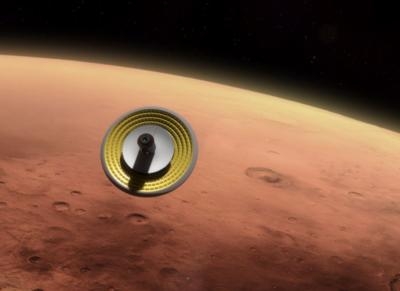Mon, Sep 28, 2015
Technology Could Be Used For Future Mars Mission
NASA is giving university and college students an opportunity to be part of the agency’s journey to Mars with the Breakthrough, Innovative, and Game-changing (BIG) Idea Challenge.

NASA’s Game Changing Development Program (GCD), managed by the agency’s Space Technology Mission Directorate in Washington, and the National Institute of Aerospace (NIA) are seeking innovative ideas for generating lift using inflatable spacecraft heat shields or hypersonic inflatable aerodynamic decelerator (HIAD) technology.
"NASA is currently developing and flight testing HIADs -- a new class of relatively lightweight deployable aeroshells that could safely deliver more than 22 tons to the surface of Mars," said Steve Gaddis, GCD manager at NASA's Langley Research Center in Hampton, Virginia. "A crewed spacecraft landing on Mars would weigh between 15 and 30 tons."
The NASA’s Mars Curiosity rover is the heaviest payload ever landed on the Red Planet -- weighing in at only one ton. To slow a vehicle carrying a significantly heavier payload through the thin Martian atmosphere and safely land it on the surface is a significant challenge. NASA is addressing this challenge through the development of large aeroshells that can provide enough aerodynamic drag to decelerate and deliver larger payloads. HIAD technology is a leading idea because these kinds of aeroshells can also generate lift, which would allow the agency to potentially do different kinds of missions.

Interested teams of three to five undergraduate and/or graduate students are asked to submit white papers describing their concepts by Nov. 15. Concepts may employ new approaches such as shape morphing and pneumatic actuation to dynamically alter the HIAD inflatable structure.
Selected teams will continue in the competition by submitting in the spring of 2016 full technical papers on the concept. Up to four teams will present their concepts to a panel of NASA judges at the BIG Idea Forum at Langley in April 2016.
Each finalist team will receive a $6,000 stipend to assist with full participation in the forum. BIG Idea Challenge winners will receive offers of paid internships with the GCD team at Langley, where they can potentially work toward a flight test of their concept.
(Image provided by NASA)
More News
Also: B-29 Superfortress Reunion, FAA Wants Controllers, Spirit Airlines Pulls Back, Gogo Galileo Van's Aircraft posted a short video recapping the goings-on around their reorganiz>[...]
Light Gun A handheld directional light signaling device which emits a brilliant narrow beam of white, green, or red light as selected by the tower controller. The color and type of>[...]
"The journey to this achievement started nearly a decade ago when a freshly commissioned Gentry, driven by a fascination with new technologies and a desire to contribute significan>[...]
"Our driven and innovative team of military and civilian Airmen delivers combat power daily, ensuring our nation is ready today and tomorrow." Source: General Duke Richardson, AFMC>[...]
Aircraft Conflict Predicted conflict, within EDST of two aircraft, or between aircraft and airspace. A Red alert is used for conflicts when the predicted minimum separation is 5 na>[...]
 Airborne 04.16.24: RV Update, Affordable Flying Expo, Diamond Lil
Airborne 04.16.24: RV Update, Affordable Flying Expo, Diamond Lil ANN's Daily Aero-Term (04.20.24): Light Gun
ANN's Daily Aero-Term (04.20.24): Light Gun Aero-News: Quote of the Day (04.20.24)
Aero-News: Quote of the Day (04.20.24) Aero-News: Quote of the Day (04.21.24)
Aero-News: Quote of the Day (04.21.24) ANN's Daily Aero-Term (04.21.24): Aircraft Conflict
ANN's Daily Aero-Term (04.21.24): Aircraft Conflict




